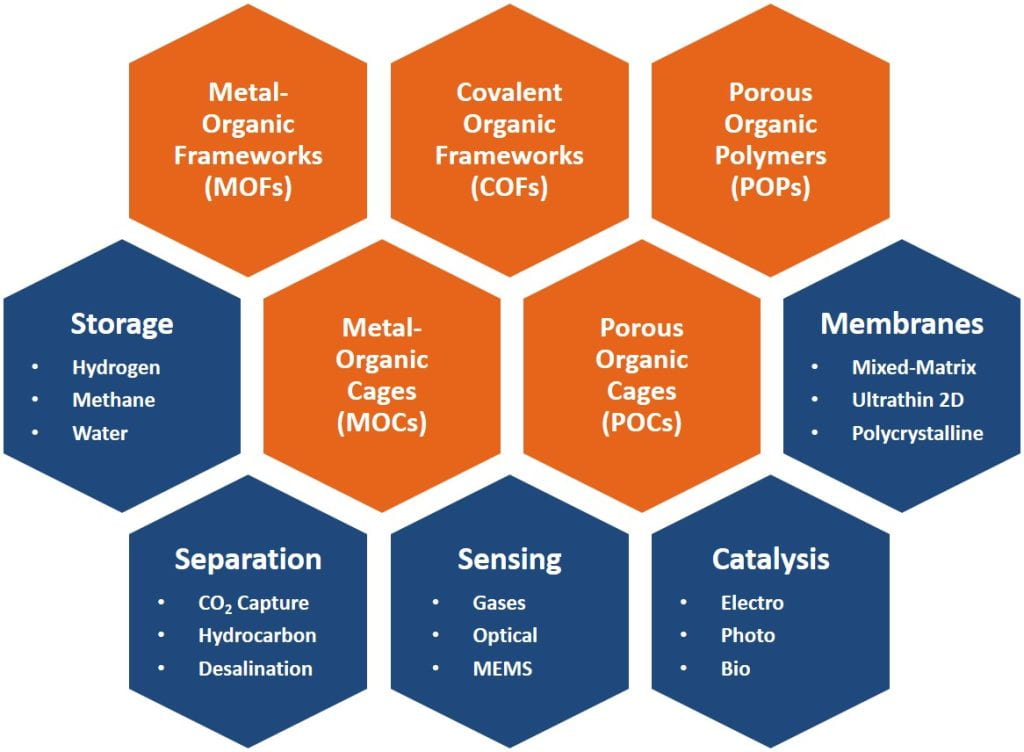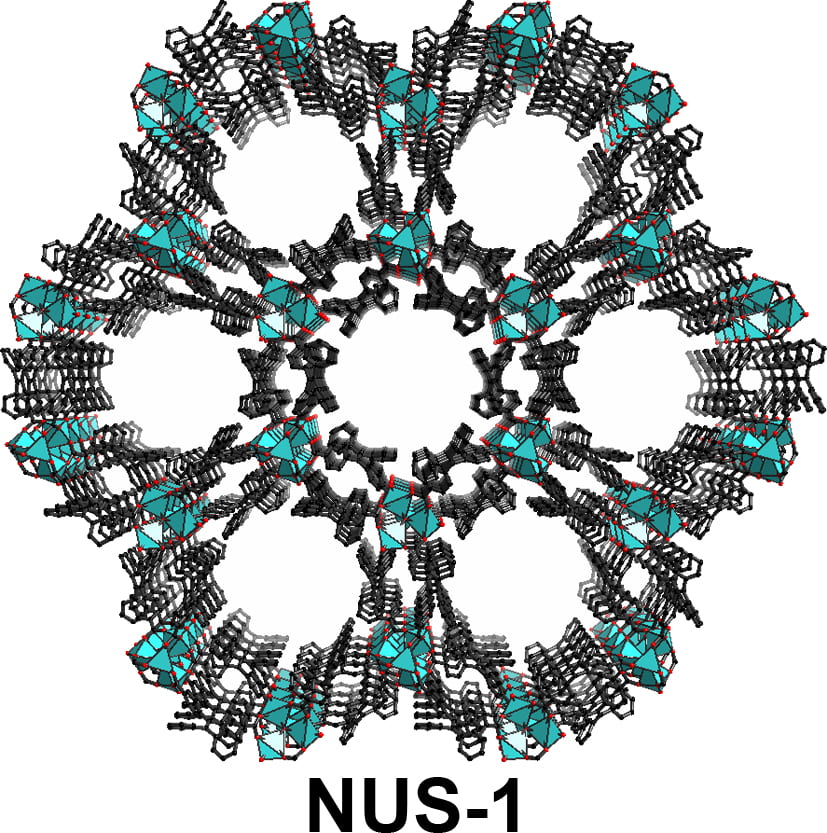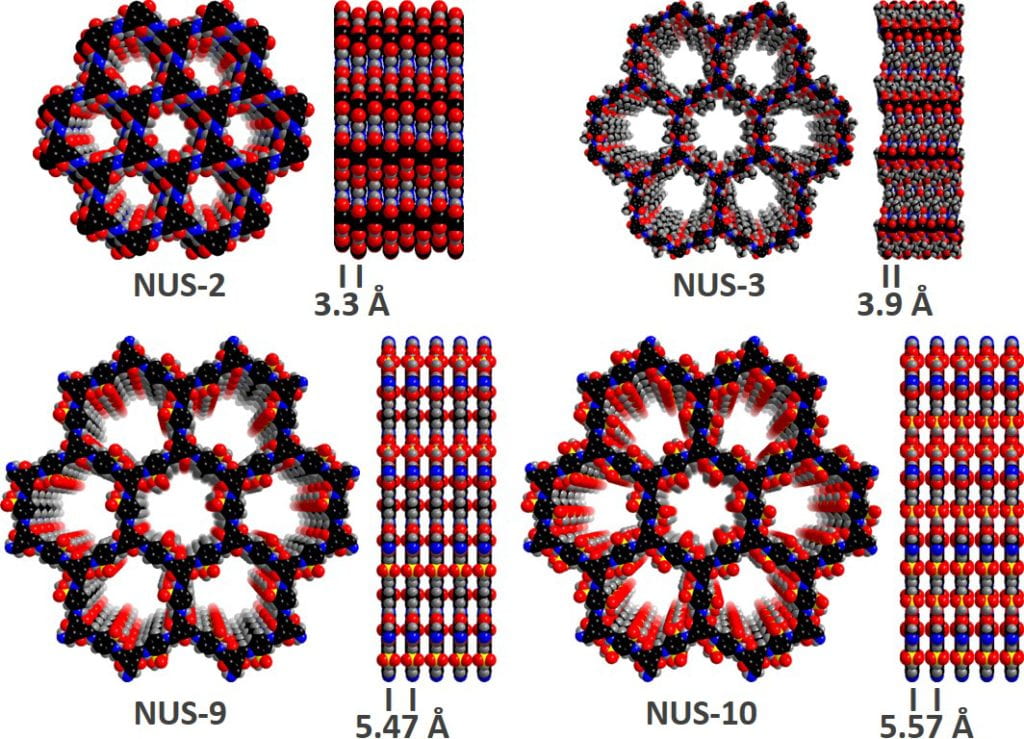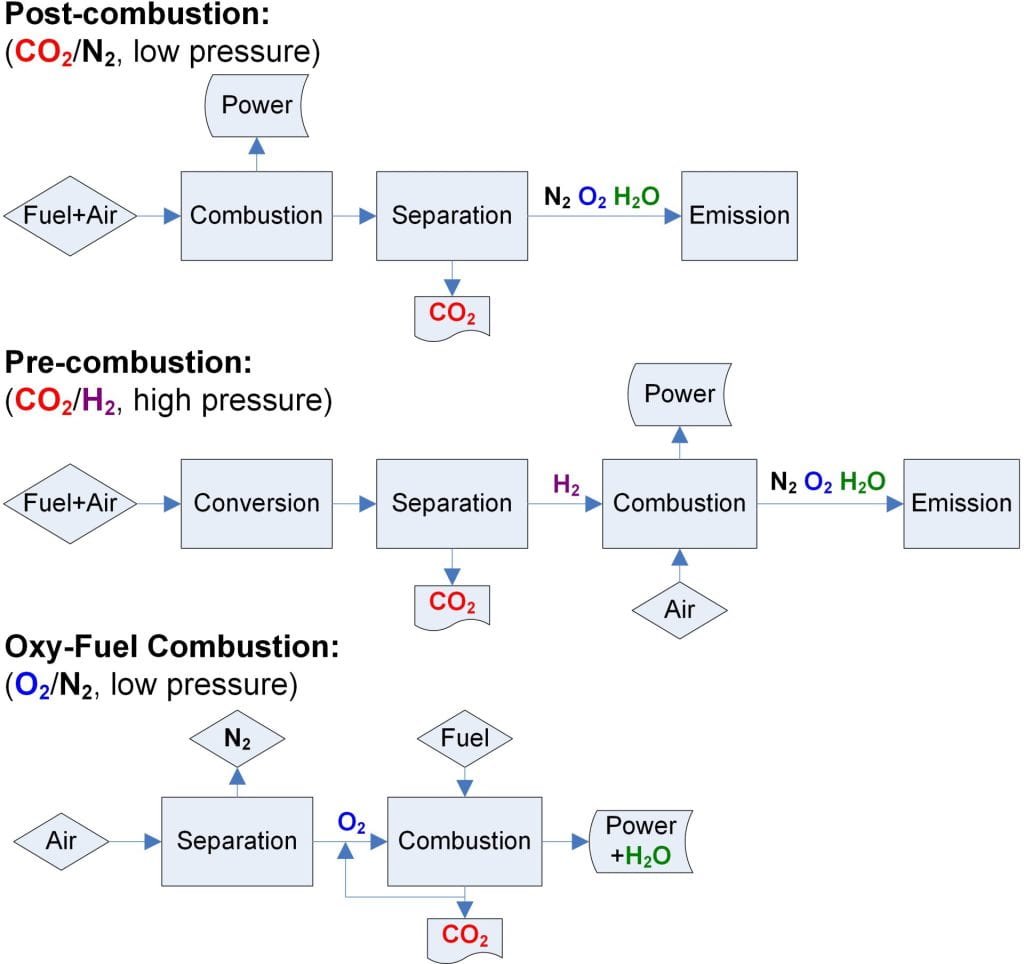Welcome to Dr. Zhao’s group in the Department of Chemical & Biomolecular Engineering, National University of Singapore. We are working on interdisciplinary areas including organic/inorganic/polymer chemistry, materials science, and chemical engineering. Our research focuses on the molecular-level design and synthesis of advanced porous materials and hybrid membranes, and their applications in clean energy and environmental sustainability such as storage, separation, sensing, and catalysis. Please click on the following items to see our interested materials and their detailed applications.

Metal-Organic Frameworks (MOFs)
Metal-organic frameworks (MOFs), which represent a new frontier of materials research, are coordination polymers consisting of metal ions/clusters as nodes and organic ligands as spacers. Possessing the merits of both inorganic and organic building units, MOFs can fill a niche in the search for new porous materials and have found wide applications in gas storage, adsorption-based gas/vapor separation, shape/size-selective catalysis, and as templates/precursors in the preparation of other porous materials. In our group, we are not only interested in designing new MOFs, but also devoted to the scale-up synthesis of commercially valuable MOFs for their industrial applications.

J. Am. Chem. Soc. 2014, 136, 7241
Representative Papers
- Peh, S. B.; Xi, S. B.; Karmakar, A.; Yeo, J. Y.; Wang, Y. X.; Zhao, D.* Accelerated formation kinetics of a multicomponent metal–organic framework derived from preferential site occupancy. Inorg. Chem. 2020, 59, 9350-9355.
- Peh, S. B.; Karmakar, A.; Zhao, D.* Multiscale design of flexible metal–organic frameworks. Trends Chem. 2020, 2, 199-213. (Front Cover)
- Peh, S. B.; Wang, Y. X.; Zhao, D.* Scalable and sustainable synthesis of advanced porous materials. ACS Sustainable Chem. Eng. 2019, 7, 3647-3670. (Invited Review in the Thematic Issue “Advanced Porous Materials: Design, Synthesis and Application in Sustainability”)
- Hu, Z. G.; Peng, Y. W.; Kang, Z. X.; Qian, Y. H.; Zhao, D.* A modulated hydrothermal (MHT) approach for the facile synthesis of UiO-66-type MOFs. Inorg. Chem. 2015, 54, 4862-4868.
- Zhang, M.; Feng, G. X.; Song, Z. G.; Zhou, Y. P.; Chao, H. Y.; Yuan, D. Q.; Tan, T. T. Y.; Guo, Z. G.; Hu, Z. G.; Tang, B. Z.*; Liu, B.*; Zhao, D.* Two-dimensional metal-organic framework with wide channels and responsive turn-on fluorescence for the chemical sensing of volatile organic compounds. J. Am. Chem. Soc. 2014, 136, 7241-7244. (Highly Cited Paper in Web of Science Aug 2020)
Covalent Organic Frameworks (COFs)
As a new member of the porous crystalline materials family, covalent organic frameworks (COFs) are pure organic polymers composed of strong covalent bonds with light elements such as B, C, N, and O. Unlike conventional polymers which are amorphous or semi-crystalline, COFs are highly crystalline materials, whose structures can be determined by X-ray or electron diffraction techniques. We are especially interested in the crystallization process of COFs, and how this will affect their performance as adsorbent materials and membrane materials.

Chem. Mater. 2016, 28, 1277
ACS Appl. Mater. Interfaces 2016, 8, 18505
Representative Papers
- Kang, C. J.; Zhang, Z. Q.; Wee, V.; Usadi, A. K.; Calabro, D. C.; Baugh, L. S.; Wang, S.; Wang, Y. X.; Zhao, D.* Interlayer shifting in two-dimensional covalent organic frameworks. J. Am. Chem. Soc. 2020, 142, 12995-13002. (Supplementary Cover)
- Peng, Y. W.; Wong, W. K.; Hu, Z. G.; Cheng, Y. D.; Yuan, D. Q.; Khan, S. A.*; Zhao, D.* Room temperature batch and continuous flow synthesis of water-stable covalent organic frameworks (COFs). Chem. Mater. 2016, 28, 5095-5101. (Top Download in Aug 2016)
- Peng, Y. W.; Xu, G. D.; Hu, Z. G.; Cheng, Y. D.; Chi, C. L.; Yuan, D. Q.; Cheng, H. S.*; Zhao, D.* Mechanoassisted synthesis of sulfonated covalent organic frameworks with high intrinsic proton conductivity. ACS Appl. Mater. Interfaces 2016, 8, 18505-18512.
Porous Organic Polymers (POPs)
Porous organic polymers (POPs) are amorphous porous materials with two-dimensional (2D) or three-dimensional (3D) structures formed by strong C-C covalent bonds. Synthesized by irreversible coupling or cross-linking reactions, POPs do not have long-range order like MOFs and COFs, but possess superior stability helping them survive in harsh conditions. Thanks to their wholly organic nature, POPs can be easily decorated with various functionalities to give them extra properties. We have invented a series of POPs with guest-responsive luminescent features, which are promising for chemical sensing.

Chem. Mater. 2016, 28, 7889
Representative Papers
- Dong, J. Q.; Li, X.; Zhang, K.; Yuan, Y. D.; Wang, Y. X.; Zhai, L. Z.; Liu, G. L.; Yuan, D. Q.; Jiang, J. W.; Zhao, D.* Confinement of aggregation induced emission (AIE) molecular rotors in ultrathin two-dimensional porous organic nanosheets for enhanced molecular recognition. J. Am. Chem. Soc. 2018, 140, 4035-4046.
- Dong, J. Q.; Zhang, K.; Li, X.; Qian, Y. H.; Zhu, H.; Yuan, D. Q.; Xu, Q. H.; Jiang, J. W.; Zhao, D.* Ultrathin two-dimensional porous organic nanosheets with molecular rotors for chemical sensing. Nat. Commun. 2017, 8, 1142.
- Dong, J. Q.; Tummanapelli, A. K.; Li, X.; Ying, S. M.; Hirao, H.*; Zhao, D.* Fluorescent porous organic frameworks containing molecular rotors for size-selective recognition. Chem. Mater. 2016, 28, 7889-7897.
Molecular Cages
Molecular cages such as metal-organic cages (MOCs) and porous organic cages (POCs) are discreet, shape-persistent porous molecules that possess defined cage-like structures with intrinsic cavities. The windows and pore environment of the cavities may be modified for molecular sieving and recognition. In addition, the molecular nature of those materials makes them solution-processable and compatible with large-scale membrane fabrication. We are studying the fundamental features of the molecular cages, such as diffusivity, solubility, and stability, as well as developing novel chemistry to process them into valuable products.

Angew. Chem. Int. Ed. 2020, 59, 10151
Representative Papers
- Yuan, Y. D.; Dong, J. Q.; Liu, J.; Zhao, D. H.; Wu, H.; Zhou, W.; Gan, H. X.; Tong, Y. W.; Jiang, J. W.*; Zhao, D.* Porous organic cages as synthetic water channels. Nat. Commun. 2020, 11, 4927. (Behind the Paper)
- Dong, J. Q.; Pan, Y. T.; Wang, H.; Yang, K. W.; Liu, L. M.; Qiao, Z. W.; Yuan, Y. D.; Peh, S. B.; Zhang, J.; Shi, L. L.; Liang, H.; Han, Y.; Li, X. P.; Jiang, J. W.; Liu, B.*; Zhao, D.* Self-assembly of highly stable zirconium (IV) coordination cages with aggregation induced emission (AIE) molecular rotors for live-cell imaging. Angew. Chem. Int. Ed. 2020, 59, 10151-10159. (Dedicated to the 20 Anniversary of Aggregation Induced Emission)
- Liu, G. L.; Yuan, Y. D.; Wang, J.; Cheng, Y. D.; Peh, S. B.; Wang, Y. X.; Qian, Y. H.; Dong, J. Q.; Yuan, D. Q.*; Zhao, D.* Process-tracing study on the postassembly modification of highly stable zirconium metal-organic cages. J. Am. Chem. Soc. 2018, 140, 6231-6234.
Storage
The interaction of gas and vapor molecules with porous materials through adsorption may be used to enrich and store these molecules. Efficient storage of fuel gases such as hydrogen and natural gas is a new paradigm in defining sustainable energy pathways. We are interested in developing novel porous materials with flexible structures and strong interactions with fuel gases to give high deliverable capacity under ambient conditions. Besides fuel gases, water vapor can also be adsorbed by porous materials for water harvesting and adsorptive cooling. However, the regeneration step can be quite energy-intensive for these processes. Our strategy in this direction is to develop stimuli-responsive porous materials with mild regeneration conditions and accordingly low energy consumption.

Chem. Mater. 2019, 31, 2842
Representative Papers
- Karmakar, A.; Mileo, P. G. M.; Bok, I.; Peh, S. B.; Zhang, J.; Yuan, H. Y.; Maurin, G.*; Zhao, D.* Thermo-responsive MOF/polymer composites for temperature mediated water capture and release. Angew. Chem. Int. Ed. 2020, 59, 11003-11009. (Back Cover)
- Kundu, T.; Wahiduzzaman, M.; Shah, B. B.; Maurin, G.; Zhao, D.* Solvent induced control over breathing behavior in flexible metal-organic frameworks for natural gas delivery. Angew. Chem. Int. Ed. 2019, 58, 8073-8077. (Very Important Paper)
- Kundu, T.; Shah, B. B.; Bolinois, L.; Zhao, D.* Functionalization induced breathing control in metal-organic frameworks for methane storage with high deliverable capacity. Chem. Mater. 2019, 31, 2842-2847. (Supplementary Cover)
- Bolinois, L.; Kundu, T.; Wang, X. R.; Wang, Y. X.; Hu, Z. G.; Koh, K.; Zhao, D.* Breathing-induced new phase transition in an MIL-53(Al)-NH2 metal-organic framework under high methane pressures. Chem. Commun. 2017, 53, 8118-8121. (Inside Back Cover)
Separation
The different affinity of porous materials toward various guests may be exploited for separation. Chromatography and several adsorptive separation processes such as pressure swing adsorption (PSA) and temperature swing adsorption (TSA) rely on differing rates of mass transfer to obtain highly pure products. Our porous materials can be used in addressing some of the most challenging separation processes, such as CO2 capture and hydrocarbon separations. We are focusing on low-cost porous materials with minimum moisture interference to capture CO2 from low-concentration sources such as power plants with natural gas combined cycle (NGCC). For hydrocarbon separations, we are interested in olefin/paraffin separation and liquid C6-C8 separation, which is the cornerstone in the modern petrochemical industry.

Adv. Sustainable Syst. 2019, 3, 1800080
Representative Papers
- Peh, S. B.; Zhao, D.* Tying amines down for stable CO2 capture. Science 2020, 369, 372-373.
- Zhang, Z. Q.; Peh, S. B.; Wang, Y. X.; Kang, C. J.; Fan, W. D.; Zhao, D.* Efficient trapping of trace acetylene from ethylene in an ultramicroporous metal–organic framework: synergistic effect of high-density open metal and electronegative sites. Angew. Chem. Int. Ed. 2020, 59, 18927-18932. (Front Cover, Hot Paper)
- Wang, Y. X.; Peh, S. B.; Zhao, D.* Alternatives to cryogenic distillation: advanced porous materials in adsorptive light olefin/paraffin separations. Small 2019, 15, 1900058.
- Hu, Z. G.*; Wang, Y. X.; Shah, B. B.; Zhao, D.* CO2 capture in metal-organic framework adsorbents: an engineering perspective. Adv. Sustainable Syst. 2019, 3, 1800080. (Inside Back Cover, Highlighted on AdvancedScienceNews.com)
- Hu, Z. G.; Wang, Y. X.; Farooq, S.; Zhao, D.* A highly stable metal-organic framework with optimum aperture size for CO2 capture. AIChE J. 2017, 63, 4103-4114. (Session’s Best Paper at 2016 AIChE Meeting, Top Downloaded Article 2017-2018)
Sensing
The emerging Internet of Things (IoT) and Industrial Internet of Things (IIoT) rely heavily on sensor technology, in which gas/smell sensing remains as one of the most challenging tasks. Because of their high surface area and tunable porosity, porous materials can be used to pre-concentrate and distinguish gas molecules for improved sensitivity and selectivity. We are the pioneers in introducing molecular rotors into porous materials for fluorescent chemosensors. In addition, our porous materials can be applied as functional coatings in microelectromechanical systems (MEMS) for the development of miniaturized and integrated sensors.

Angew. Chem. Int. Ed. 2019, 58, 14089
Representative Papers
- Yuan, H. Y.; Li, N. X.; Linghu, J. J.; Dong, J. Q.; Wang, Y. X.; Karmakar, A.; Yuan, J. R.; Li, M. S.; Buenconsejo, P. J. S.; Liu, G. L.; Cai, H.; Pennycook, S. J.; Singh, N.; Zhao, D.* Chip-level integration of covalent organic frameworks for trace benzene sensing. ACS Sens. 2020, 5, 1474-1481.
- Li, N. X.; Yuan, H. Y.; Xu, L. F.; Tao, J. F.; Ng, D. K. T.; Lee, L. Y. T.; Cheam, D. D.; Zeng, Y. Q.; Qiang, B.; Wang, Q. J.; Cai, H.*; Singh, N.; Zhao, D.* Radiation enhancement by graphene oxide on MEMS emitters for highly selective gas sensing. ACS Sens. 2019, 4, 2746-2753. (Supplementary Cover)
- Yuan, H. Y.; Tao, J. F.; Li, N. X.; Karmakar, A.; Tang, C. H.; Cai, H.*; Pennycook, S. J.; Singh, N.; Zhao, D.* On-chip tailorability of capacitive gas sensors integrated with metal-organic framework films. Angew. Chem. Int. Ed. 2019, 58, 14089-14094. (Front Cover, Very Important Paper)
- Yuan, H. Y.; Aljneibi, S. A. A. A.; Yuan, J. R.; Wang, Y. X.; Liu, H.; Fang, J.; Tang, C. H.; Yan, X. H.; Cai, H.; Gu, Y. D.; Pennycook, S. J.; Tao, J. F.*; Zhao, D.* ZnO nanosheets abundant in oxygen vacancies derived from metal-organic frameworks for ppb-level gas sensing. Adv. Mater. 2019, 31, 1807161. (Inside Front Cover, Highly Cited Paper in Web of Science Aug 2020)
Catalysis
The versatile chemical composition and tunable porosity make advanced porous materials ideal catalysts in heterogeneous catalysis. So far, our research in this direction has mainly focused on sulfonated MOFs and COFs as solid acid catalysts in biomass conversation, especially the conversion of fructose to hydroxymethylfurfural (HMF), which is one of the most important platform compounds in biomass conversion processes. Besides using porous materials directly as the catalysts, we are also interested in pyrolyzing them into carbon-based materials as electrocatalysts for oxygen reduction reaction (ORR) and oxygen evolution reaction (OER) in batteries and fuel cells, or as photocatalysts for energy and environment related reactions such as water splitting and pollutant degradation.

Small 2017, 13, 1701143
Representative Papers
- Zhai, L. Z.; Qian, Y. H.; Wang, Y. X.; Cheng, Y. D.; Dong, J. Q.; Peh, S. B.; Zhao, D.* In-situ formation of micropore-rich titanium dioxide from metal–organic framework templates. ACS Appl. Mater. Interfaces 2018, 10, 36933-36940.
- Qian, Y. H.; An, T.; Birgersson, K. E.; Liu, Z. L.; Zhao, D.* Web-like interconnected carbon networks from NaCl-assisted pyrolysis of ZIF-8 for highly efficient oxygen reduction catalysis. Small 2018, 1704169. (Inside Front Cover, Top Downloaded Paper 2018-2019)
- Qian, Y. H.; Hu, Z. G.; Ge, X. M.; Yang, S. L.; Peng, Y. W.; Kang, Z. X.; Liu, Z. L.; Lee, J. Y.; Zhao, D.* A metal-free ORR/OER bifunctional electrocatalyst derived from metal-organic frameworks for rechargeable Zn-Air batteries. Carbon 2017, 111, 641-650. (Highly Cited Paper in Web of Science Aug 2020)
- Hu, Z. G.; Peng, Y. W.; Gao, Y. J.; Qian, Y. H.; Ying, S. M.; Yuan, D. Q.; Horike, S.; Ogiwara, N.; Babarao, R.; Wang, Y. X.; Yan, N.; Zhao, D.* Direct synthesis of hierarchically porous metal-organic frameworks with high stability and strong Brønsted acidity: the decisive role of hafnium in efficient and selective fructose dehydration. Chem. Mater. 2016, 28, 2659-2667.
- Peng, Y. W.; Hu, Z. G.; Gao, Y. J.; Yuan, D. Q.; Kang, Z. X.; Qian, Y. H.; Yan, N.; Zhao, D.* Synthesis of a sulfonated two-dimensional covalent organic framework as an efficient solid acid catalyst for biobased chemical conversion. ChemSusChem 2015, 19, 3208-3212. (Back Cover)
Membranes
Membrane-based separation processes have the advantages of easy operation, facile scalability, and low footprint. The combination of porous materials in hybrid membranes would dramatically improve membrane performance with possibly better stability. We are particularly interested in the following membrane types: mixed matrix membranes (MMMs), ultrathin 2D membranes (2DMs), and polycrystalline membranes (PCMs). These membranes will be evaluated in several industrial gas and liquid separation processes, such as H2 purification, natural gas upgrading, CO2 capture, seawater desalination, and organic solvent nanofiltration (OSN).

Nat. Commun. 2017, 8, 14460
Representative Papers
- Zhai, L. Z.; Yu, X.; Wang, Y. X.; Zhang, J.; Ying, Y. P.; Cheng, Y. D.; Peh, S. B.; Liu, G. L.; Wang, X. R.; Cai, Y. H.; Zhao, D.* Polycrystalline rare-earth metal-organic framework membranes with in-situ healing ability for efficient alcohol dehydration. J. Membr. Sci. 2020, 610, 118239.
- Ying, Y. P.; Tong, M. M.; Ning, S. C.; Ravi, S. K.; Peh, S. B.; Tan, S. C.; Pennycook, S. J.; Zhao, D.* Ultrathin two-dimensional membranes assembled by ionic covalent organic nanosheets with reduced apertures for gas separation. J. Am. Chem. Soc. 2020, 142, 4472-4480. (Front Cover)
- Cheng, Y. D.; Zhai, L. Z.; Ying, Y. P.; Wang, Y. X.; Liu, G. L.; Dong, J. Q.; Ng, D. Z. L.; Khan, S. A.; Zhao, D.* Highly efficient CO2 capture by mixed matrix membranes containing three-dimensional covalent organic framework fillers. J. Mater. Chem. A 2019, 7, 4549-4560.
- Wang, X. R.; Chi, C. L.; Zhang, K.; Qian, Y. H.; Gupta, K. M.; Kang, Z. X.; Jiang, J. W.; Zhao, D.* Reversed thermo-switchable molecular sieving membranes composed of two-dimensional metal-organic nanosheets for gas separation. Nat. Commun. 2017, 8, 14460. (Highly Cited Paper in Web of Science Aug 2020)
- Kang, Z. X.; Peng, Y. W.; Qian, Y. H.; Yuan, D. Q.; Addicoat, M. A.; Heine, T.; Hu, Z. G.; Tee, L.; Guo, Z. G.; Zhao, D.* Mixed matrix membranes (MMMs) comprising exfoliated 2D covalent organic frameworks (COFs) for efficient CO2 separation. Chem. Mater. 2016, 28, 1277-1285. (Top Download in Feb 2016, Highly Cited Paper in Web of Science Aug 2020)
